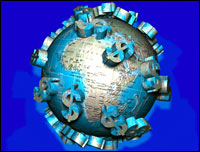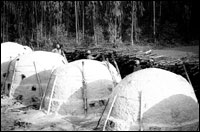
For as long as it’s been around, the World Bank has been prone to mission creep. Established 60 years ago to rebuild war-torn Europe, it morphed into an institution whose raison d’etre was to help developing countries advance, then refined its focus on poverty alleviation and sustainable development in the 1980s and ’90s. During that time, it took on the role of effectively creating international environmental and social rules for development finance. Now the bank has recast itself to pursue a mission some call its creepiest yet.
Nearly a decade ago, the institution began making plans to enter a new market: carbon trading. This invisible business, devised during talks leading up to the Kyoto Protocol, provides credits to polluting countries and industries that invest in “carbon-saving” projects, such as methane capture or tree-planting programs, in developing countries.
Supporters of carbon trading assert that it allows the invisible hand of the market to meet, and even exceed, emissions goals more cheaply than conventional regulation. But critics charge that it slows structural change toward a non-fossil fuel economy, and robs the poor of their rights.
One thing is for sure: this new market — known as the “Clean Development Mechanism,” or CDM, under Kyoto — is gaining steam, and the World Bank has become its major player. Investors predict carbon could become one of the largest markets in the world, with a trading volume of $60 billion to $250 billion by 2008.
Since working its way into the business in 1999, the bank has invested in some projects that arguably harm local landscapes and residents. During the same time, it has also spent billions of dollars financing fossil-fuel extraction projects — contributing to the very industry whose impacts carbon trading seeks to lessen.
“While the bank’s [purpose] was to help establish a market that catalyzed private-sector investment in climate-friendly projects, it has now largely crowded out the private sector,” says Ben Pearson, of the Indonesia-based CDM Watch. “It now dominates the carbon market.”
Entering the Fray
Eight years ago — the same year parties to the pre-Kyoto U.N. Framework Convention on Climate Change were hammering out the CDM — confidential World Bank documents were leaked to the Institute for Policy Studies, a progressive think thank based in Washington, D.C. [Editor’s note: the author is an IPS fellow.] In a self-appointed role as broker between northern and southern governments and industries, one leaked document showed, the bank would profit handsomely by charging a 5 percent commission on CDM transactions. The memo noted that with the potential to capture $2 billion of the market by 2005, the World Bank could quickly earn $100 million in one year. (This “commission,” which the bank says merely covers costs, is now closer to 8 to 10 percent.)
None of the signatories to the Climate Convention or the Kyoto Protocol had asked the World Bank to play this role. In fact, many, including U.S. Treasury officials, actively discouraged it, recognizing potential conflicts of interest. But the bank is rarely accountable to national or international governmental bodies — the U.S. government is its largest shareholder — and it simply took the task upon itself.
The bank debuted its Prototype Carbon Fund in 1999, portraying it as an opportunity to work out the glitches in the CDM before it was launched globally. PCF director Ken Newcombe said the fund would be “entirely renewable,” with solar, wind, micro-hydro, and geothermal power projects making up its portfolio. As time passed, it became clear that the PCF was far from renewable; in fact, it followed the more forthright trajectory laid out in the leaked 1997 document — namely, pursuing the low-hanging fruit of the global carbon market.
Fast-forward to 2004. At an event sponsored by the International Emissions Trading Association and the World Bank at climate negotiations in Buenos Aires, Newcombe emphasized that nitrous oxide* and hydrofluorocarbons, not renewables, were the most attractive candidates for carbon financiers.
“One would expect that CDM would support wind, solar, and small hydro,” he reported. “But the CDM methodologies … and an unlevel playing field for renewable energy … make it very difficult.”
A Strange and Bitter Crop
Faced with the difficult situation Newcombe describes, the World Bank has invested in some locally damaging projects. Take the notoriously toxic Bisasar dump in Durban, South Africa. The dump, opened in this brown and black community by white rulers under apartheid, has made residents sick for years. Despite cleanup pledges made during the mid-1990s by African National Congress leaders, the World Bank wants to keep the landfill open as a source of “clean” power. The town stands to profit twice: by transforming captured methane into electricity and selling the power locally, and by reaping money from the PCF.
Then there’s a deal the bank made in India: last June, Newcombe signed a letter of intent to purchase 880,000 tons of carbon credits from the FaL-G brick and block industry. FaL-G bricks and blocks are made from fly ash, a byproduct of coal combustion. Unlike clay bricks, they can be constructed without the use of thermal energy, ostensibly making them a greener choice. But it’s not that simple. “Coal fly ash typically contains a range of heavy metals, a range of radioactive elements, a range of poly-aromatic hydrocarbons, and other semi-volatile contaminants,” says Pat Costner, former senior scientist at Greenpeace, noting that those handling the material are at great risk of exposure. “The thought of turning over the management of fly ash to the hundreds or perhaps thousands of tiny brick-making operations in India is enough to make the soul shiver.”
In Brazil, a company called Plantar owns a monoculture eucalyptus grove covering about 57,000 acres. The fast-growing trees will be harvested and used as charcoal for the production of low-grade iron. For small farmers nearby, the consequences of this plantation are devastating: streams and swamps have dried up, chemicals contaminate the air and water, and the diverse species that once inhabited the land have all but vanished. These plantations are allegedly avoiding the production of 4.3 million tons of carbon dioxide that would have been emitted had coal been used for smelting. That’s 4.3 million carbon credits that can be sold to a party unwilling to reduce its emissions by the same amount. But in the next two decades, these trees will be cut down. The CO2 produced by northern industries that have bought the PCF’s credits will remain in the atmosphere, on average, 50 to 200 years.
Last year, the bank created another carbon fund, and a third is in the works. In addition, it administers funds for individual countries, including the Netherlands, Italy, Spain, and Denmark. If these projects continue to grow, the World Bank will have helped create — and cornered — a market that undercuts its own mission.
Put Your Money Where Your … Money Is
It’s complicated enough when an institution dedicated to improving conditions around the globe invests in potentially harmful projects. But the World Bank’s fuzzy role doesn’t end there. The bank is also one of the largest public sources of funds for the fossil-fuel industry.
From 1992 through late 2004, the World Bank Group approved $11 billion in financing for 128 fossil-fuel extraction projects in 45 countries. These projects will lead to more than 43 billion tons of carbon-dioxide emissions. And more than 82 percent of World Bank financing for oil extraction has gone to projects that export oil back to wealthy countries.
This institutional schizophrenia — carbon trader and fossil-fuel financier — evolved over the last couple of decades. Since the 1980s, under pressure from the Reagan administration, the bank has pried open developing countries’ fossil-fuel sectors in order to satisfy the growing import needs of industrialized countries. In 1981, the U.S. Treasury urged the bank to play a lead role in the “expansion and diversification of global energy supplies to enhance security of supplies and reduce OPEC market power over oil prices.” The treasury also noted that, as opposed to the U.S. government, the neutral bank could play an important role in fostering foreign corporate investment in developing countries’ energy sectors.
The bank implemented these directives with great success. Then came the 1992 Rio Earth Summit, progenitor of the Kyoto Protocol, which placed much of the financial control over sustainable development aid — particularly clean-energy financing — within the bank. That should have changed things. But research conducted by the Institute for Policy Studies’ Sustainable Energy & Economy Network shows unprecedented levels of bank financing for fossil-fuel projects in the past decade, and threadbare support for renewable energy and energy-efficiency projects. In an average year, the World Bank supported fossil-fuel projects with lifetime emissions of 1,457 megatons of carbon. This figure is at least four, and as much as 29, times the amount of annual emissions reductions anticipated under the CDM.

Protesters in Indonesia, 2004.
Photo: Jonathan McIntosh.
The primary direct beneficiaries of these fossil-fuel projects are northern corporations, particularly those based in the United States. They benefit either through direct loans or through the privatization process enforced by bank loans. Halliburton and Enron, for example, enjoyed global expansion in the 1990s hand-in-glove with the World Bank Group. And the bank’s impact reaches far beyond the projects it funds. More than 75 percent of all private banks — so-called Equator Principle banks — base their standards upon those of the World Bank. Public banks also look to the venerable institution for guidance.
Many people, from the world’s most disenfranchised to Nobel laureates to internal whistleblowers, have tried to convince the bank to realign its energy portfolio during the past decade. Last year, an exhaustive review self-commissioned by the bank and chaired by former Indonesian environment minister Emil Salim called upon the institution to divest its portfolio of the most egregious fossil-fuel projects. But the bank’s action plan adopted in September represented business as usual.
In October, several dozen representatives of independent organizations in the global south gathered to discuss realistic avenues for addressing climate change. The resulting Durban Declaration, signed by more than 150 organizations from around the world, reads, in part, “In an absurd contradiction, the World Bank facilitates … false, market-based approaches to climate change … at the same time it is promoting, on a far greater scale, the continued exploration for, and extraction and burning of, fossil fuels — many of which are to ensure increased emissions of the north.”
Those who embrace the bank as an impartial and honest carbon broker ought to be aware that this institution’s investments are driven largely by oil-hungry nations. This became particularly clear with President Bush’s nomination of Iraq war architect and assistant secretary of Defense Paul Wolfowitz to head up the institution in mid-March. Activists say the bank must change; they are calling for greater input from more countries’ elected officials, and oversight by the United Nations. Meanwhile, a growing movement spanning several continents is taking a more radical approach: it is pushing for a boycott of World Bank bonds, with the aim of ending the institution’s investments in environmentally and socially destructive projects.
*[Correction, 31 Mar 2005: The article originally stated that Newcombe emphasized nitrogen dioxide as an attractive candidate for carbon financiers. In fact, he recommended nitrous oxide.]




